Avoiding Lyapunov-Krasovskii Functionals: Simple Nonlinear Sampled–Data Control of a Semi-Active Suspension with Magnetorheological Dampers
Abstract
1. Introduction
2. Semi-Active Suspension Model
- (1)
- To improve ride comfort, it is essential to minimize the vertical acceleration
- (2)
- The suspension deflection is constrained by the mechanical structure and must not exceed a specified maximum value
- (3)
- To ensure consistent and uninterrupted contact between the wheels and the road, it is essential for the dynamic tire load to remain below the static tire load
3. MR Damper Controller with Robustness to Nonlinear Sampled-Data
4. Results
- A road bump with a height of cm and a length of m at a vehicle speed of km/h. The road bump profile as a function of time is described by the following equation:Conducting a bump test is a straightforward but revealing way to evaluate how well the suspension handles sharp, high-energy disturbances.
- A Class A random road profile, according to ISO 8608 [48], under a vehicle speed of km/h. The purpose of evaluating the suspension system under this profile is to ensure that its performance remains consistent under typical highway conditions; that is, to verify that the semi-active control does not intervene unnecessarily when it is not required to.
5. Conclusions
Author Contributions
Funding
Institutional Review Board Statement
Informed Consent Statement
Data Availability Statement
Conflicts of Interest
Abbreviations
| IMU | Inertial Measurement Unit |
| LMI | Linear Matrix Inequality |
| LPV | Linear Parameter-Varying |
| LVDT | Linear Variable Differential Transformer |
| MR | Magnetorheological |
| NDTL | Normalized Dynamic Tire Load |
| PSD | Power Spectral Density |
| RMS | Root Mean Square |
References
- Wang, Z.; Liu, C.; Zheng, X.; Zhao, L.; Qiu, Y. Advancements in Semi-Active Automotive Suspension Systems with Magnetorheological Dampers: A Review. Appl. Sci. 2024, 14, 7866. [Google Scholar] [CrossRef]
- Sharp, R.; Crolla, D. Road vehicle suspension system design-a review. Veh. Syst. Dyn. 1987, 16, 167–192. [Google Scholar] [CrossRef]
- Yoon, D.S.; Choi, S.B. Adaptive control for suspension system of in-wheel motor vehicle with magnetorheological damper. Machines 2024, 12, 433. [Google Scholar] [CrossRef]
- Arshad, M.W.; Lodi, S.; Liu, D.Q. Multi-Objective Optimization of Independent Automotive Suspension by AI and Quantum Approaches: A Systematic Review. Machines 2025, 13, 204. [Google Scholar] [CrossRef]
- Viadero-Monasterio, F.; Boada, B.; Boada, M.; Díaz, V. H∞ dynamic output feedback control for a networked control active suspension system under actuator faults. Mech. Syst. Signal Process. 2022, 162, 108050. [Google Scholar] [CrossRef]
- Hu, Y.; Chen, M.Z.; Shu, Z. Passive vehicle suspensions employing inerters with multiple performance requirements. J. Sound Vib. 2014, 333, 2212–2225. [Google Scholar] [CrossRef]
- Sename, O. Review on LPV approaches for suspension systems. Electronics 2021, 10, 2120. [Google Scholar] [CrossRef]
- Li, G.; Ruan, Z.; Gu, R.; Hu, G. Fuzzy sliding mode control of vehicle magnetorheological semi-active air suspension. Appl. Sci. 2021, 11, 10925. [Google Scholar] [CrossRef]
- Viadero-Monasterio, F.; Jimenez-Salas, M.; Meléndez-Useros, M.; Boada, B.L.; Boada, M.J.L. Event-triggered fault-tolerant control for vehicle rollover avoidance based on an active suspension with robustness against disturbances and communication delays. In Proceedings of the IFToMM World Congress on Mechanism and Machine Science, Tokyo, Japan, 5–10 November 2023; Springer: Berlin/Heidelberg, Germany, 2023; pp. 795–805. [Google Scholar]
- Jeong, Y.; Yim, S. Design of active suspension controller for ride comfort enhancement and motion sickness mitigation. Machines 2024, 12, 254. [Google Scholar] [CrossRef]
- Basargan, H.; Mihály, A.; Gáspár, P.; Sename, O. An LPV-based online reconfigurable adaptive semi-active suspension control with MR damper. Energies 2022, 15, 3648. [Google Scholar] [CrossRef]
- Hua, Y. The riding comfort improvement by the paralleled semi-active magnetorheological damper and passive inertance suspension from the power perspective. J. Vib. Control 2025, 31, 457–471. [Google Scholar] [CrossRef]
- Yu, S.; Guo, J.; Xu, M.; Zhang, S.; Zhuang, Y.; Lin, B. Road preview MPC of semi-active suspension with magneto-rheological damper. Int. J. Robust Nonlinear Control 2025, 35, 2736–2759. [Google Scholar] [CrossRef]
- Shi, Z.; Cao, R.; Zhang, S.; Guo, J.; Yu, S.; Chen, H. Active suspension H∞/generalized H2 static output feedback control. J. Vib. Control 2024, 30, 5183–5195. [Google Scholar] [CrossRef]
- Soudani, M.S.; Aouiche, A.; Ghanai, M.; Chafaa, K. Advanced active suspension control: A three-input fuzzy logic approach with jerk feedback for enhanced performance and robustness. Measurement 2024, 229, 114326. [Google Scholar] [CrossRef]
- Li, M.; Xu, J.; Wang, Z.; Liu, S. Optimization of the semi-active-suspension control of BP neural network PID based on the sparrow search algorithm. Sensors 2024, 24, 1757. [Google Scholar] [CrossRef]
- Tipsuwan, Y.; Chow, M.Y. Control methodologies in networked control systems. Control Eng. Pract. 2003, 11, 1099–1111. [Google Scholar] [CrossRef]
- Park, J.H.; Lee, T.H.; Liu, Y.; Chen, J. Dynamic Systems with Time Delays: Stability and Control; Springer: Berlin/Heidelberg, Germany, 2019; Volume 4. [Google Scholar]
- Kamen, E. Linear systems with commensurate time delays: Stability and stabilization independent of delay. IEEE Trans. Autom. Control 1982, 27, 367–375. [Google Scholar] [CrossRef]
- Hale, J.K.; Lunel, S.M.V. Effects of small delays on stability and control. In Operator Theory and Analysis; The MA Kaashoek Anniversary Volume Workshop in Amsterdam, 12–14 November 1997; Springer: Berlin/Heidelberg, Germany, 2001; pp. 275–301. [Google Scholar]
- Shen, Z.; Liu, Y.; Li, Z.; Wu, Y. Distributed vehicular platoon control considering communication delays and packet dropouts. J. Frankl. Inst. 2024, 361, 106703. [Google Scholar] [CrossRef]
- Cai, J.; Guo, D.; Wang, W. Adaptive fault-tolerant control of uncertain systems with unknown actuator failures and input delay. Meas. Control 2024, 00202940241289217. [Google Scholar] [CrossRef]
- Zhang, K.; Braverman, E. Event-Triggered Impulsive Control for Nonlinear Systems with Actuation Delays. IEEE Trans. Autom. Control 2023, 68, 540–547. [Google Scholar] [CrossRef]
- Aslam, M.S.; Shamrooz, S.; Bilal, H. Fuzzy PD-sliding mode control design for networked system with time delays. Eur. J. Control 2024, 78, 101020. [Google Scholar] [CrossRef]
- Nguyen, A.T.; Frezzatto, L.; Guerra, T.M.; Delprat, S. Cost-Effective Estimation of Vehicle Lateral Tire-Road Forces and Sideslip Angle via Nonlinear Sampled-Data Observers: Theory and Experiments. IEEE/ASME Trans. Mechatron. 2024, 29, 4606–4617. [Google Scholar] [CrossRef]
- Borri, A. A Nonlinear Sampled-Data Observer of Vehicle Lateral Velocity. IEEE Control Syst. Lett. 2017, 1, 244–249. [Google Scholar] [CrossRef]
- Zhang, X.M.; Han, Q.L.; Ge, X.; Ning, B.; Zhang, B.L. Sampled-data control systems with non-uniform sampling: A survey of methods and trends. Annu. Rev. Control 2023, 55, 70–91. [Google Scholar] [CrossRef]
- Jang, Y.H.; Kim, H.S. Sampled-data cooperative adaptive cruise control for string-stable vehicle platooning with communication delays: A linear matrix inequality approach. Machines 2024, 12, 165. [Google Scholar] [CrossRef]
- Viadero-Monasterio, F.; Nguyen, A.T.; Lauber, J.; Boada, M.J.L.; Boada, B.L. Event-Triggered Robust Path Tracking Control Considering Roll Stability Under Network-Induced Delays for Autonomous Vehicles. IEEE Trans. Intell. Transp. Syst. 2023, 24, 14743–14756. [Google Scholar] [CrossRef]
- Zhao, R.; Huang, W.; Xie, H. Adaptive neural network backstepping control for the magnetorheological semi-active air suspension system with uncertain mass and time-varying input delay. J. Vib. Control 2024, 10775463241288953. [Google Scholar] [CrossRef]
- Boyd, S.; El Ghaoui, L.; Feron, E.; Balakrishnan, V. Linear Matrix Inequalities in System and Control Theory; SIAM: Philadelphia, PA, USA, 1994. [Google Scholar]
- Karami, H.; Nguyen, N.P.; Ghadiri, H.; Mobayen, S.; Bayat, F.; Skruch, P.; Mostafavi, F. LMI-Based Luenberger Observer Design for Uncertain Nonlinear Systems With External Disturbances and Time-Delays. IEEE Access 2023, 11, 71823–71839. [Google Scholar] [CrossRef]
- Kim, C. Robust H∞ Static Output Feedback Control for TCP/AQM Routers Based on LMI Optimization. Electronics 2024, 13, 2165. [Google Scholar] [CrossRef]
- Viadero-Monasterio, F.; Boada, B.L.; Zhang, H.; Boada, M.J.L. Integral-Based Event Triggering Actuator Fault-Tolerant Control for an Active Suspension System Under a Networked Communication Scheme. IEEE Trans. Veh. Technol. 2023, 72, 13848–13860. [Google Scholar] [CrossRef]
- Seuret, A.; Gouaisbaut, F. Hierarchy of LMI conditions for the stability analysis of time-delay systems. Syst. Control Lett. 2015, 81, 1–7. [Google Scholar] [CrossRef]
- Samaroo, K.; Awan, A.W.; Marimuthu, S.; Iqbal, M.N.; Daniel, K.; Shabbir, N. Performance Investigation of Active, Semi-Active and Passive Suspension Using Quarter Car Model. Algorithms 2025, 18, 100. [Google Scholar] [CrossRef]
- Nagarkar, M.; Bhalerao, Y.; Sashikumar, S.; Hase, V.; Navthar, R.; Zaware, R.; Thakur, A.; Wable, A.; Ashtekar, J.; Surner, N. Multi-objective optimization and experimental investigation of quarter car suspension system. Int. J. Dyn. Control 2024, 12, 1222–1238. [Google Scholar] [CrossRef]
- Meléndez-Useros, M.; Jiménez-Salas, M.; Viadero-Monasterio, F.; López-Boada, M.J. Novel Methodology for Integrated Actuator and Sensors Fault Detection and Estimation in an Active Suspension System. IEEE Trans. Reliab. 2025, 74, 2171–2184. [Google Scholar] [CrossRef]
- Viadero-Monasterio, F.; Meléndez-Useros, M.; Jiménez-Salas, M.; Boada, B.L. Robust Static Output Feedback Control of a Semi-Active Vehicle Suspension Based on Magnetorheological Dampers. Appl. Sci. 2024, 14, 10336. [Google Scholar] [CrossRef]
- Li, H.; Gao, H.; Liu, H.; Liu, M. Fault-tolerant H∞ control for active suspension vehicle systems with actuator faults. Proc. Inst. Mech. Eng. Part I J. Syst. Control Eng. 2012, 226, 348–363. [Google Scholar] [CrossRef]
- Leon-Vargas, F.; Garelli, F.; Zapateiro, M. Limiting vertical acceleration for ride comfort in active suspension systems. Proc. Inst. Mech. Eng. Part I J. Syst. Control Eng. 2018, 232, 223–232. [Google Scholar] [CrossRef]
- Mantaras, D.A.; Luque, P. Ride comfort performance of different active suspension systems. Int. J. Veh. Des. 2006, 40, 106–125. [Google Scholar] [CrossRef]
- Chen, G.; Du, G.; Xia, J.; Xie, X.; Wang, Z. Aperiodic Sampled-Data H∞ Control of Vehicle Active Suspension System: An Uncertain Discrete-Time Model Approach. IEEE Trans. Ind. Inform. 2024, 20, 6739–6750. [Google Scholar] [CrossRef]
- Viadero-Monasterio, F.; Meléndez-Useros, M.; Jiménez-Salas, M.; Boada, M.J.L. Fault-Tolerant Robust Output-Feedback Control of a Vehicle Platoon Considering Measurement Noise and Road Disturbances. IET Intell. Transp. Syst. 2025, 19, e70007. [Google Scholar] [CrossRef]
- Zhang, X.M.; Han, Q.L. Event-triggered dynamic output feedback control for networked control systems. IET Control Theory Appl. 2014, 8, 226–234. [Google Scholar] [CrossRef]
- Ding, R.; Wang, R.; Meng, X.; Chen, L. Research on time-delay-dependent H∞/H2 optimal control of magnetorheological semi-active suspension with response delay. J. Vib. Control 2023, 29, 1447–1458. [Google Scholar] [CrossRef]
- Zhao, R.; Xie, H.; Gong, X.; Sun, X.; Cao, C. Neural network-based adaptive height tracking control of active air suspension system with magnetorheological fluid damper subject to uncertain mass and input delay. Sensors 2023, 24, 156. [Google Scholar] [CrossRef]
- ISO 8608:2016; Mechanical Vibration—Road Surface Profiles—Reporting of Measured Data. International Organization for Standardization: Geneva, Switzerland, 2016.
- Xie, D.; Chen, L.; Liu, L.; Chen, L.; Wang, H. Actuators and sensors for application in agricultural robots: A review. Machines 2022, 10, 913. [Google Scholar] [CrossRef]
- Viadero-Monasterio, F.; Meléndez-Useros, M.; Zhang, H.; Boada, B.L.; Boada, M.J.L. Signalized Traffic Management Optimizing Energy Efficiency Under Driver Preferences for Vehicles With Heterogeneous Powertrains. IEEE Trans. Consum. Electron. 2025; early access. [Google Scholar] [CrossRef]
- Chen, X.; Wang, Z.; Shi, H.; Jiang, N.; Zhao, S.; Qiu, Y.; Liu, Q. Review of Agricultural Machinery Seat Semi-Active Suspension Systems for Ride Comfort. Machines 2025, 13, 246. [Google Scholar] [CrossRef]
- Ferhath, A.A.; Kasi, K. The evolution of damper technology for enhanced ride comfort and vehicle handling in vehicle suspension system. Int. J. Dyn. Control 2024, 12, 3908–3946. [Google Scholar] [CrossRef]
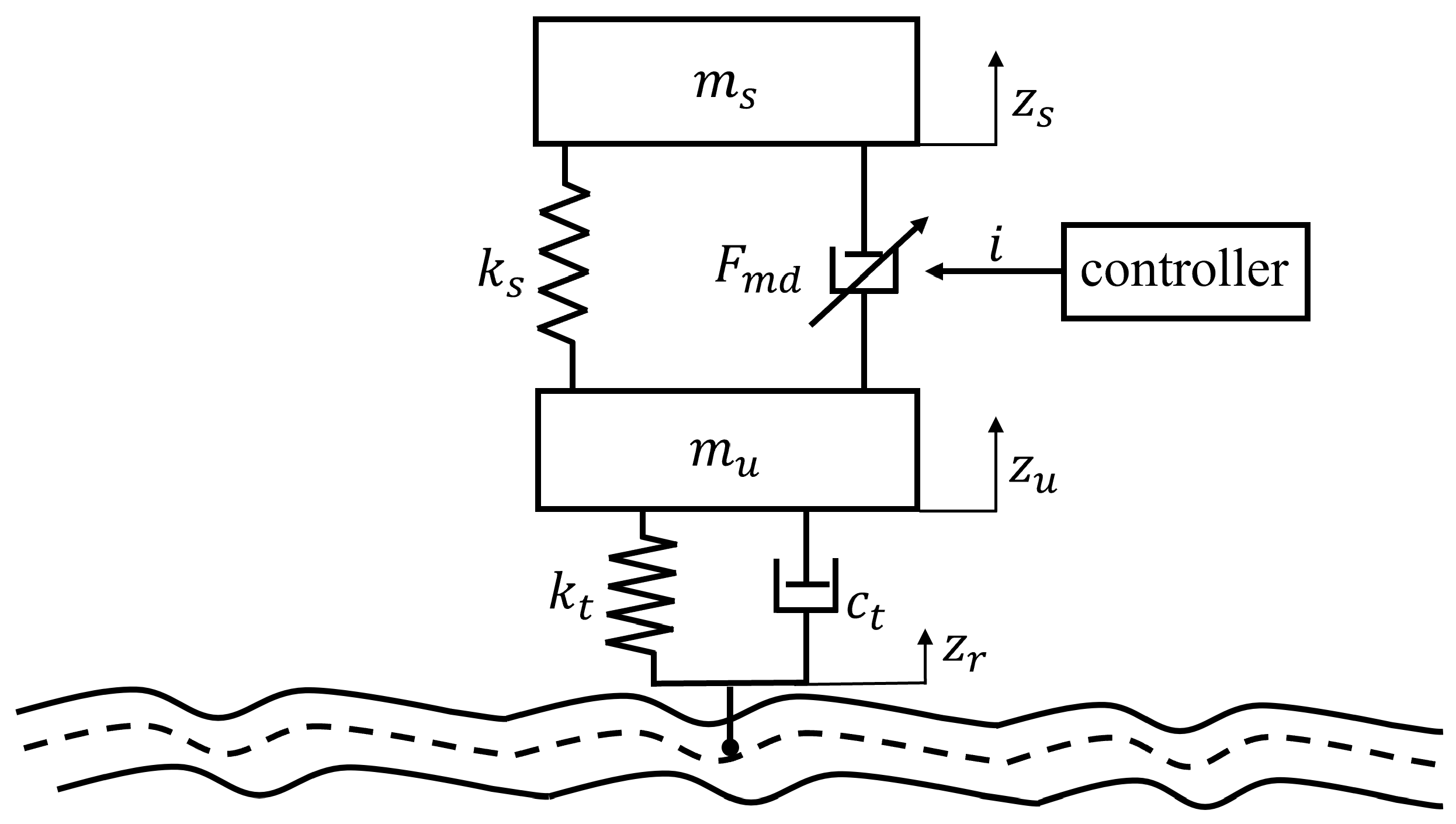
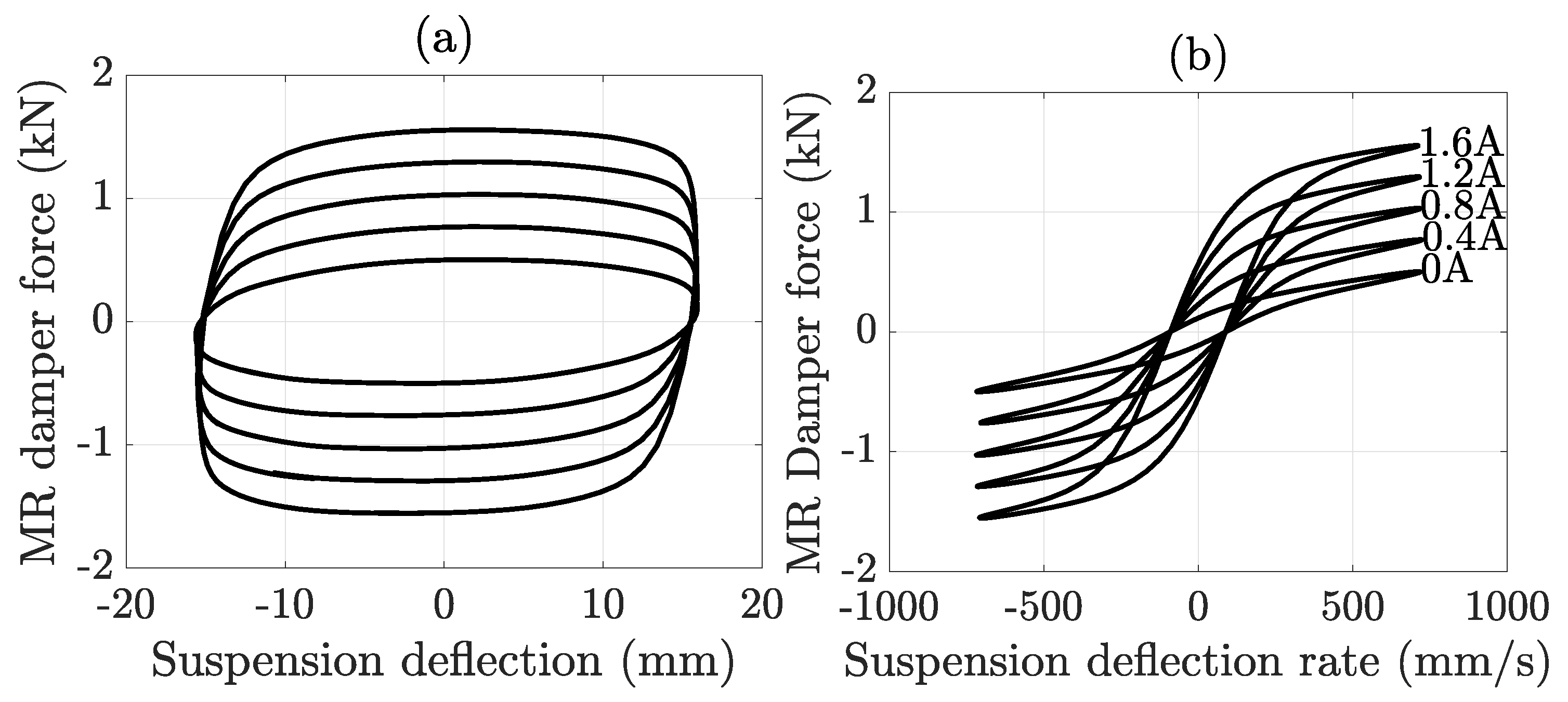
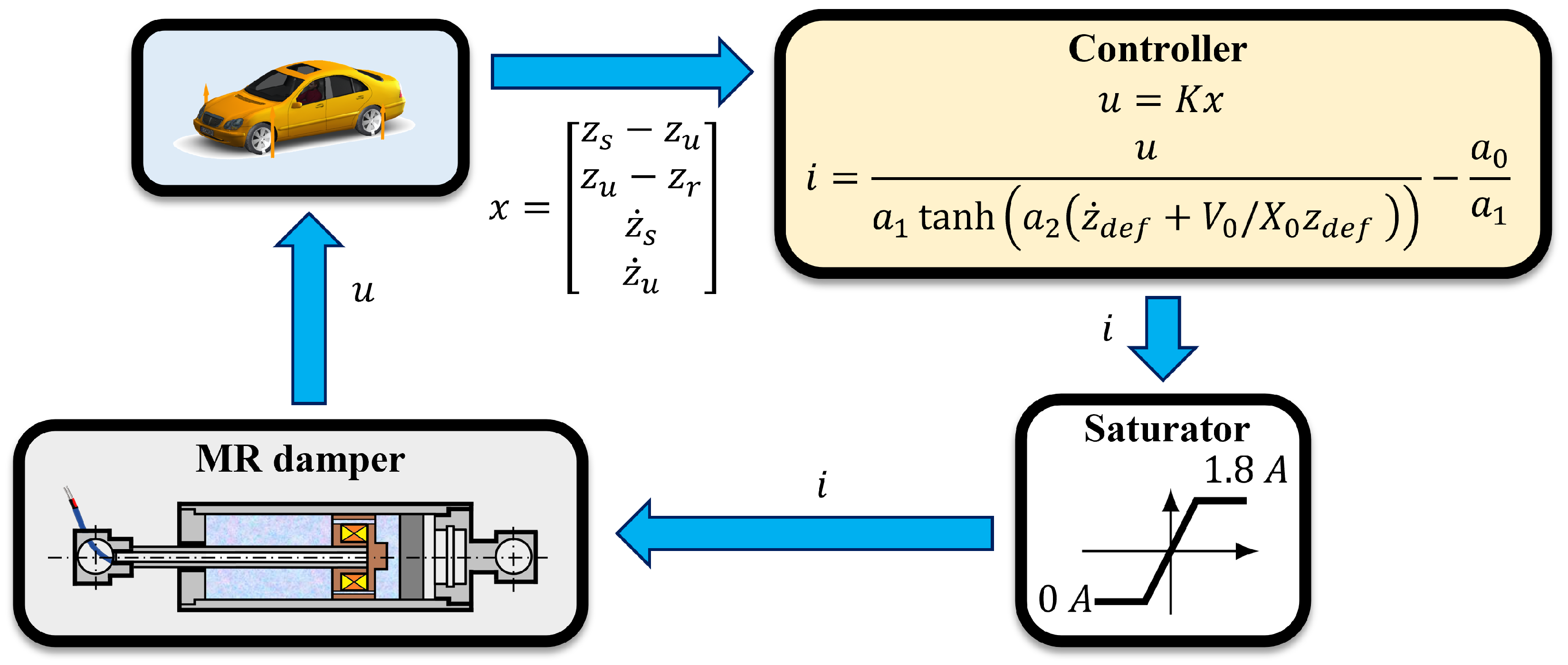
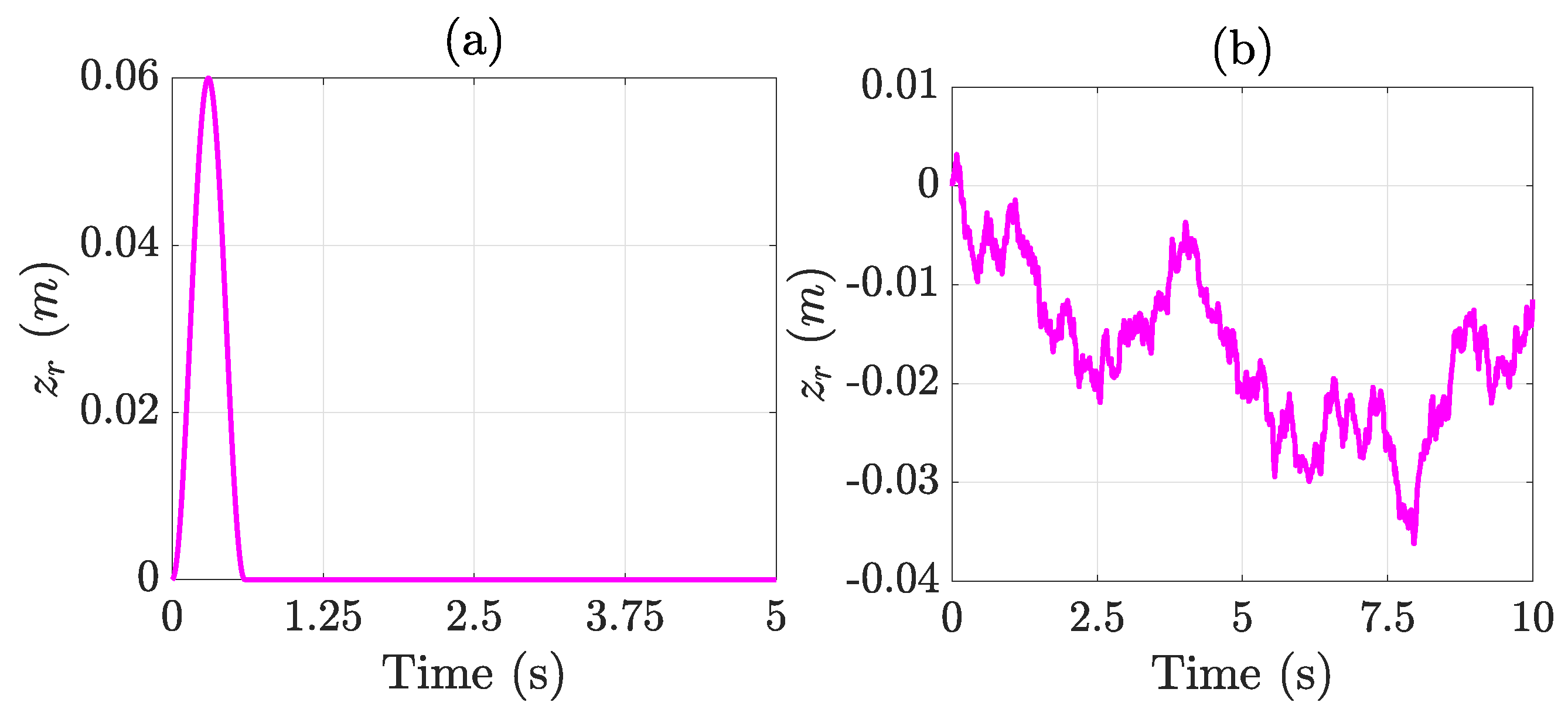

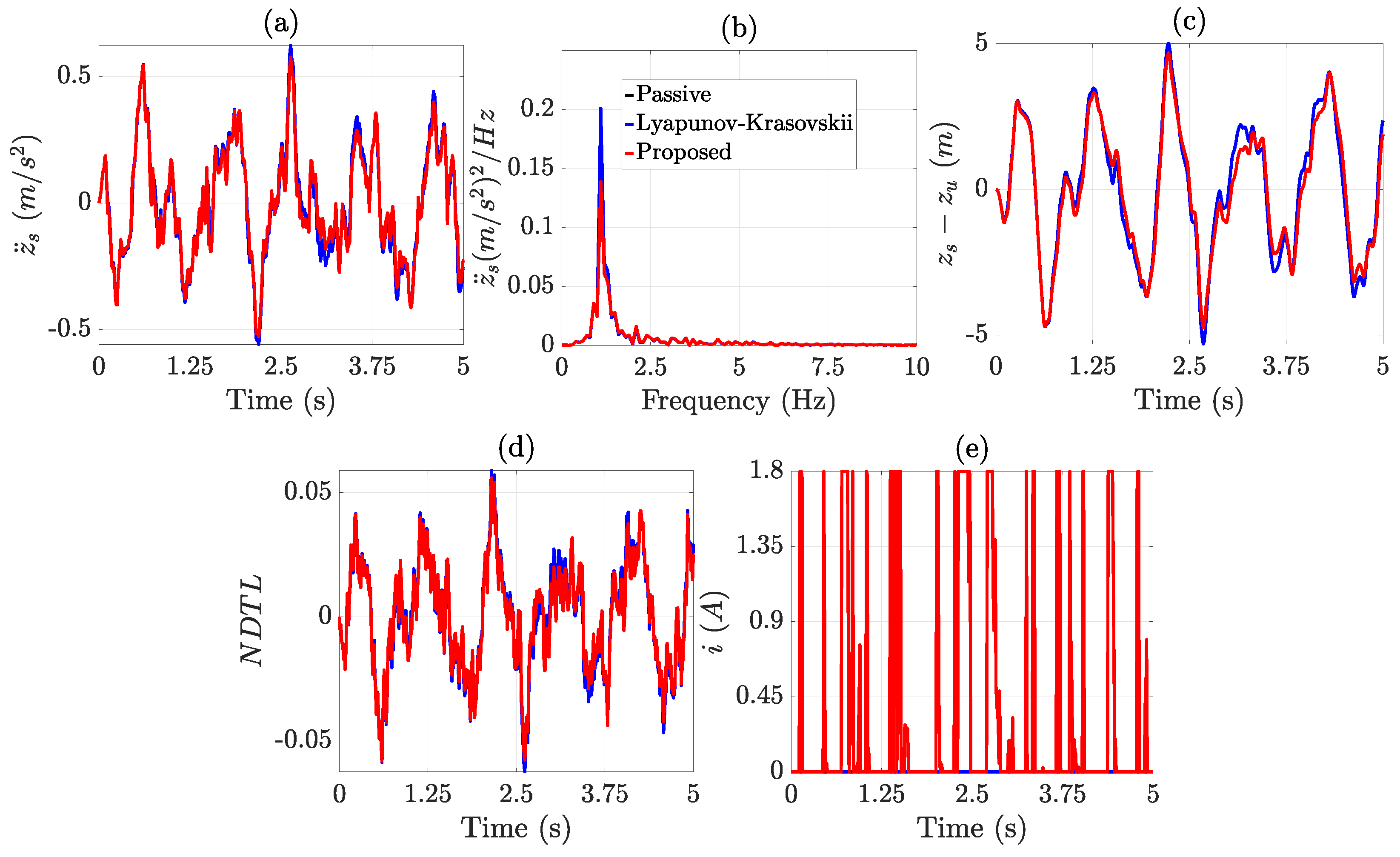
| Parameter | Name | Value |
|---|---|---|
| Vehicle sprung mass | 243.2 kg | |
| Vehicle unsprung mass | 28.5 kg | |
| Spring stiffness | 10,680 N/m | |
| Tire stiffness | 25,278 N/m | |
| Tire damping | 3.65 N s/m | |
| Maximum suspension deflection | 0.05 m |
| Parameter | Value |
|---|---|
| 236.3 N | |
| 655.8 N/A | |
| 4.67 s/m | |
| 343.1 N s/m | |
| 6.05 s−1 |
| Vehicle Speed | Passive | Lyapunov-Krasovskii | Proposed |
|---|---|---|---|
| 15 km/h | 0.775 m/s2 | 0.772 m/s2 | 0.721 m/s2 |
| 20 km/h | 1.059 m/s2 | 1.055 m/s2 | 0.977 m/s2 |
| 25 km/h | 1.113 m/s2 | 1.109 m/s2 | 1.017 m/s2 |
| Vehicle Speed | Passive | Lyapunov-Krasovskii | Proposed |
|---|---|---|---|
| 50 km/h | 0.200 m/s2 | 0.199 m/s2 | 0.187 m/s2 |
| 60 km/h | 0.211 m/s2 | 0.211 m/s2 | 0.196 m/s2 |
| 70 km/h | 0.240 m/s2 | 0.240 m/s2 | 0.227 m/s2 |
| 80 km/h | 0.255 m/s2 | 0.255 m/s2 | 0.241 m/s2 |
Disclaimer/Publisher’s Note: The statements, opinions and data contained in all publications are solely those of the individual author(s) and contributor(s) and not of MDPI and/or the editor(s). MDPI and/or the editor(s) disclaim responsibility for any injury to people or property resulting from any ideas, methods, instructions or products referred to in the content. |
© 2025 by the authors. Licensee MDPI, Basel, Switzerland. This article is an open access article distributed under the terms and conditions of the Creative Commons Attribution (CC BY) license (https://creativecommons.org/licenses/by/4.0/).
Share and Cite
Viadero-Monasterio, F.; Meléndez-Useros, M.; Jiménez-Salas, M.; López Boada, M.J. Avoiding Lyapunov-Krasovskii Functionals: Simple Nonlinear Sampled–Data Control of a Semi-Active Suspension with Magnetorheological Dampers. Machines 2025, 13, 512. https://doi.org/10.3390/machines13060512
Viadero-Monasterio F, Meléndez-Useros M, Jiménez-Salas M, López Boada MJ. Avoiding Lyapunov-Krasovskii Functionals: Simple Nonlinear Sampled–Data Control of a Semi-Active Suspension with Magnetorheological Dampers. Machines. 2025; 13(6):512. https://doi.org/10.3390/machines13060512
Chicago/Turabian StyleViadero-Monasterio, Fernando, Miguel Meléndez-Useros, Manuel Jiménez-Salas, and María Jesús López Boada. 2025. "Avoiding Lyapunov-Krasovskii Functionals: Simple Nonlinear Sampled–Data Control of a Semi-Active Suspension with Magnetorheological Dampers" Machines 13, no. 6: 512. https://doi.org/10.3390/machines13060512
APA StyleViadero-Monasterio, F., Meléndez-Useros, M., Jiménez-Salas, M., & López Boada, M. J. (2025). Avoiding Lyapunov-Krasovskii Functionals: Simple Nonlinear Sampled–Data Control of a Semi-Active Suspension with Magnetorheological Dampers. Machines, 13(6), 512. https://doi.org/10.3390/machines13060512








